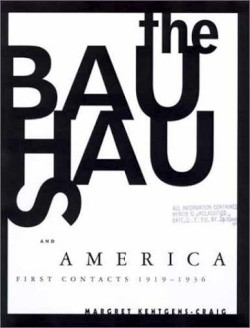
The Bauhaus and America
First Contacts, 1919-1936
In 1933, the Bauhaus in Dessau was dissolved by the Third Reich. Hitler ordered the “intellectual and ideological education and training of artists” to be placed under surveillance. Dr. Goebbels published a manifesto which included, among other things, “prohibition of boxlike architecture.” Prior to the school’s closing, however, protagonists of the movement had already spread its ideas to the United States.
Kentgens-Craig, Head of the Department of Archives and Collections at the Bauhaus Dessau Foundation, chronicles the acceptance of the Bauhaus in America. Her work is scholarly and thorough, though sometimes repetitive and filled with detailed minutiae. She catalogues many examples of a growing Bauhaus influence: from the landmark show “Modern Architecture: International Exhibition,” which opened at the MOMA in 1932, to an increasing number of articles published in professional periodicals on the movement and its leaders, to American students who attended the Bauhaus, to visits by Mies van der Rohe and Walter Gropius to America in order to promote their careers and ideas. Ultimately, Gropius was appointed as a professor at Harvard, and Mies became the dean at Chicago’s Armour Institute.
Despite this expansive web of contact, the Bauhaus was not transplanted to America in its original form. In Germany, the Bauhaus had been a combination of art school and a social movement calling for a future in which all the arts were united and “the wall of conceit that separates the artist from the workman” eliminated. Furthermore, the Bauhaus was different in each of its incarnations under its directors Gropius, Mies and Hannes Meyer. In America, however, the Bauhaus is mostly identified with its existence in Dessau under Gropius.
In the 1930s, the United States was searching for new solutions in commercial, industrial, institutional and residential building. It looked to the European avant-garde for an architecture that reflected its new building technology and social needs. Kentgens-Craig posits that it was this confluence of needs and solutions that led Americans to accept the German movement, despite many cultural and political prejudices.
America received the Bauhaus primarily as a school of architecture. The movement was largely misinterpreted as an attempt to create a “style,” a formal vocabulary divorced from the social content its founders intended. Kentgens-Craig suggests that this misinterpretation allowed many of the school’s ideas to be integrated into American culture, despite the radical differences between German and American society in the 1930’s.
Reviewed by
Jill Blue Lin
Disclosure: This article is not an endorsement, but a review. The publisher of this book provided free copies of the book to have their book reviewed by a professional reviewer. No fee was paid by the publisher for this review. Foreword Reviews only recommends books that we love. Foreword Magazine, Inc. is disclosing this in accordance with the Federal Trade Commission’s 16 CFR, Part 255.
